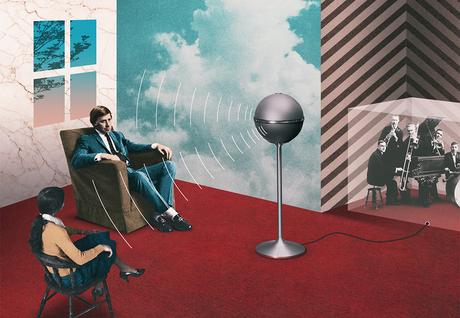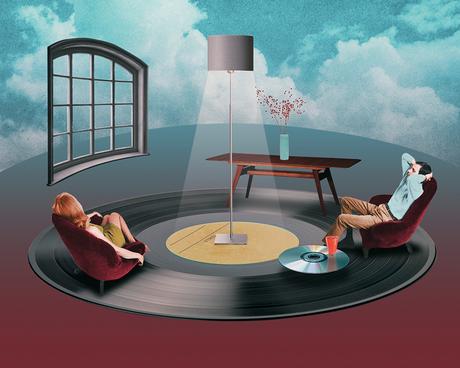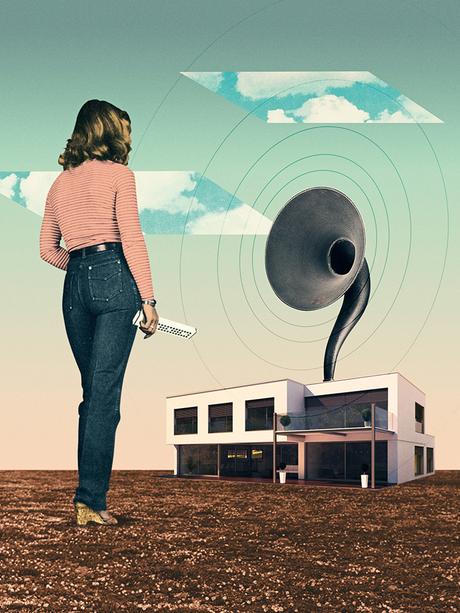
“The way people experience sound at home has evolved signifcantly since our doors opened 90 years ago."—Tue Mantoni, CEO of Bang & Olufsen
Until the arrival of the phonograph nearly 140 years ago, the only way to have music in the home was to perform it. Royals and the wealthy supported composers and performers to provide entertainment in their manor houses and castles; their residences often featured music rooms, where instrumentalists were presented front and center, like artwork on display. Other abodes placed the musicians in a separate room or loft, acoustically connected to grand halls to provide discreet accompaniment for banquets and events. Oddly enough, that dichotomy—show of the music, or hide it—still exists, even in our modern, electronic era.
In the early days of phonographs and radios, the novelty of the devices ensured they would receive pride of place in the home. Accordingly, styling was ornate and dramatic, full of Victorian and Edwardian fourishes. The wealthy could buy massive consoles, reaching a peak with a 1929 Victrola costing $1,750 at the time when a Ford Model A started at $380. (A less-conspicuous Victrola tabletop phonograph could be had then for $15.)
The end of World War II brought a glut in manufacturing production capacity and of surplus electronic components. Add in a large number of war-trained electronic designers and technicians, growth in disposable income, and Columbia’s 1948 launch of the LP record, and you get a boom in home-entertainment products.
As hi-f and television became popular in the ’50s, devices that had previously been hidden in racks or confned to laboratories entered living rooms. Again, novelty ensured these devices would be seen—and the giant theaterstyle horn loudspeakers, black metal boxes, and rack mounts that early hi-f hobbyists brought home from theaters and radio stations were no longer acceptable. Aesthetics became an important consideration in choosing the devices, and while Early American or Louis Quatorze speaker-and-equipment cabinets appeared, others led the way with modern design.
One of the pioneers of what we today call “high-end audio” was Saul Marantz. Graphic designer Marantz’s electronics featured gold faceplates and elegant typography, which is still emblematic of his products 60 years later. Charles and Ray Eames famously designed speakers for Stephens Tru-Sonic, Inc., but Arnold Wolf’s speakers for JBL were more infuential in the marketplace. Wolf’s designs, such as the Paragon, were expanses of subtly curved woods reminiscent of George Nakashima or Finn Juhl’s furniture. Worldwide, Dieter Rams’s simple, spare electronics for Braun adopted an industrial aesthetic, which still shapes products by Apple and other design-centric companies, and are wildly sought-after objects.

"We emphasize user convenience and emotional appeal."—Tue Mantoni
“Technical products like hi-f fit more easily into all kinds of surroundings than those old furniture look-alike ones,” Rams says. His designs mimicked the changes seen in technology by replacing wood-grain and cloth grilles with laminates, paint, and perforated metal grilles. “People listen to music diferently today; I would design according to that new way of listening and the new technology.”
As mono turned to stereo, and space had to be found for two speakers, “bookshelf” units such as those pioneered by Acoustic Research became the norm. Speaker design turned away from large, sculptural forms designed for the center of the room to rectangular boxes of standard sizes and proportions, which could be relegated to foors, corners—and shelves.
Similarly, as transistors replaced vacuum tubes, electronic components could be enclosed or hidden away, as the need for ventilation became less crucial. Today’s amplifers are small and cool-running enough that they can be built into speaker cabinets.
Now, massive, conspicuous amplifers and loudspeakers are primarily the domain of audiophiles, who proudly display their equipment as they would a Henry Moore sculpture or a Ferrari. With that in mind, audiophile gear often features dramatic styling and elaborate machining.
The majority of “normal” homeowners, however, prefer equipment that will either blend in with their furnishings or disappear altogether, a need made more urgent by the rise in home theater systems with fve or even seven channels of speakers. Although the style dates back to the ’50s, Bose popularized tiny speakers for mid- and high frequencies, with a single woofer enclosure handling the bass—which many feel compromises sound quality. Some contemporary makers of quality speakers offer designs for in-ceiling, in-wall, and on-wall applications, offering solutions for custom installations.
Somewhere in between the two worlds is long-established Danish manufacturer Bang & Olufsen, whose products are clearly designed to be showpieces and often feature motorized, moving elements. The industrial designer is king at B&O; speaker designers, for example, are presented with a form determined by an industrial designer, and must design the acoustic and electrical characteristics of the speaker to accommodate the predetermined form. Such a process is the reverse of most speaker-design methods, which begin with enclosure volumes and radiation characteristics, and derive the overall form from those. “The way people experience sound at home has evolved signifcantly since our doors opened 90 years ago,” says Tue Mantoni, CEO of Bang & Olufsen. “But our attitude toward design remains constant. We emphasize user convenience and emotional appeal, as well as the integration and domestication of technology.”
The strongest trend in home audio is in wireless, multiroom systems and, to that end, many well-established audio manufacturers are developing systems to compete with the hugely popular Sonos, probably the biggest audio success story of the past 20 years. Physical media such as LPs, tapes, and CDs required the user to change them periodically; digital downloads and streaming audio no longer require an “attendant,” and inter-house setups can provide diferent music in every room.
Times change, tastes change, and technologies change, but the desire for music in the home remains universal.

“Technical products like hi-fi fit more easily into all kinds of surroundings than those old furniture look-alike ones.”—Dieter Rams, designer
